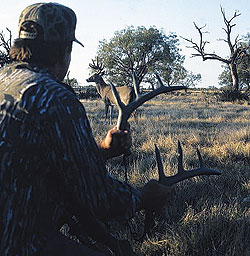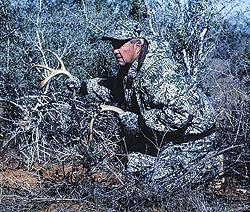November 04, 2010
By Dr. Dave Samuel
By Dr. Dave Samuel, Bob Zaiglin

Advertisement
A study in South Texas showed that rattling may be more effective than even avid horn rattlers realize. |
Advertisement
For years, no one could scientifically answer the question, "Does rattling really work?" Now someone can. Recently, Dr. Mickey Hellickson conducted a study on the response of deer to antler rattling at the Welder Wildlife Foundation Refuge in South Texas.
Cover on the 8,000-acre research refuge consists of low brush typical of the South Texas brush country. Numerous telephone-pole observation towers are scattered across the refuge. Deer numbers are high, the buck-to-doe ratio is fairly balanced, and plenty of mature bucks live on the area. Given light hunting pressure, deer on the refuge might be a little less wary than on heavily hunted areas, and they may respond better to rattling.
In Phase One of the study, Hellickson placed observers in observation towers to watch for bucks as other researchers rattled on the ground. In Phase Two, Hellickson placed activity collars on some older bucks, which allowed him to monitor the bucks' movements.
To determine the response rate of deer to various types of rattling, Hellickson set varied parameters: Loud rattling (banging the antlers together) versus soft rattling (tickling the antler points, grinding the bases). He rattled for a half-hour in each setup, in three 10-minute segments of either long rattling (seven minutes of rattling followed by three minutes of silence) or short rattling (one minute of rattling followed by nine minutes of silence). These sessions were further varied with combinations of long/loud, long/soft, short/loud, and short/soft rattling. Finally, the study covered varied times of year (pre-rut, peak-rut, and post-rut); all kinds of weather; and different times of the day.
Over a three-year period and 171 rattling sequences, Hellickson and his helpers observed 111 bucks responding.
| Rattling That Gives You Best Results |
|---|
| Early morning: | Best |
|---|
| Peak rut: | Best* |
|---|
| Less wind: | Best |
|---|
| Cool temperatures: | Best |
|---|
| 75% cloud cover: | Best |
|---|
| Loud rattling: | Best* |
|---|
| Long or Short: | No difference |
|---|
*For exceptions, see text |
Remember, those were bucks seen by the observers and persons rattling on the ground.
Here is the interesting fact: Persons rattling on the ground saw only 33 percent of the bucks seen by observers in towers. Sixty-six percent of the time, bucks did not come close enough for persons on the ground to see. Almost certainly some bucks circled downwind and vanished before being seen by anyone, because 67 of the 111 bucks that responded to rattling were first seen downwind. Clearly, an elevated position gives a person an advantage in spotting and observing approaching bucks.
Okay, rattling attracts bucks, but what approach works best? And when? During Hellickson's study (see Table 1), loud rattling brought in three times as many bucks as soft rattling. Early morning was by far the best time of day. The peak of the rut brought the peak of responses. In regard to weather, calm, cool days with 75 percent or more cloud cover proved optimum.
Relative to short or long rattling sequences, resear-chers found no difference in response rate. A higher percentage of bucks came during the first rattling sequence of each three-sequence set, but a good number showed up during the third sequence, too. The lesson? Always sit tight and rattle for at least 30 minutes.

During the study, one researcher rattled on the ground as another observed from a tower. The one in the tower saw far more bucks. |
Table 2 shows that yearling bucks and very old bucks responded a little better during the pre-rut. Bucks in the 3.5 and 4.5-year age classes responded best during the peak-rut period. The oldest bucks responded less during the peak-rut period and better during the post-rut. In fact, of the 29 bucks observed responding during the post-rut, 10 were in the 3.5 and 4.5-year age categories, and another 10 were 5.5 years old and older. The post-rut appears to be a great time to rattle, especially for older bucks.
Overall, loud rattling worked best. However -- and here's a gold nugget for hunters -- a high percentage of the oldest bucks responded to soft rattling during the post-rut period. Thus, tickling and grinding the antlers during the post-rut may be the best technique for pulling the biggest bucks within bow range.
During phase two, researchers rattled to bedded bucks wearing activity collars. The collars enabled researchers to detect when and in which direction the bucks moved. During 33 rattling sequences directed at collared bucks, 24 of the bucks came closer to the rattler. However, researchers on the ground saw only 33 percent of these deer. Average distance moved was one-third mile, but several bucks came considerably farther. In some cases, it took 30 minutes for the bucks to come near the rattler, so, again, you're wise to stick with each rattling setup for at least a half-hour.
Do bucks learn to avoid rattling? To answer this, the researchers rattled four different times over a several-week period to 11 bucks of 4.5 years of age or older. Some of these old-timers proved wise to the ways of rattling. One 9.5-year-old buck never moved during any of the rattling sequences.
However, 6 of the 11 bucks came twice to the rattling, and one came all four times. Four did not respond to the first rattling sequence but then came to the second. So even the older bucks responded well to rattling, and some came more than once during a two-week period.
| % of different age class bucks that responded in the pre-rut, rut, and post-rut. |
|---|
| AGE | PRE-RUT* | RUT** | POST-RUT*** |
|---|
| 1.5-2.5 | 39% | 33% | 31% |
|---|
| 3.5-4.5 | 28% | 48% | 34% |
|---|
| 5.5+ | 33% | 19% | 34% |
|---|
| *in pre-rut, 60 rattling sequences attracted 18 bucks (30%) |
|
| **in peak-rut, 60 rattling sequences attracted 65 bucks (107%) |
|
| ***in post-rut, 51 rattling sequences attracted 29 bucks (57%) |
|
| TIME OF DAY |
|---|
| 7:30-10:30AM | 10:30-1:30 | 1:30-4:30 |
|---|
| 94% | 40% | 53% |
|---|
As would be expected, this study demonstrates that rattling does not always work. More importantly, it demonstrates that rattling works better than most hunters realize. If you rattle in the right way at the right time, you definitely improve your chances for killing whitetail bucks.
Editor's Note: This article was adapted from "The Whitetail Advantage: Understanding Deer Behavior for Better Success," by Dr. Dave Samuel and Bob Zaiglin. For ordering information, go to www.krausebooks.com.
